Table of contents
- Tech tricks from Fireblade, GSX-R 1000, R1 & Co. That is what makes the new supersport motorcycles so good
- GSX-R 1000 combines high tech with clever engineering
- Honda Fireblade SP and SP2
- Kawasaki ZX-10 RR
- BMW S 1000 RR and Yamaha YZF-R1
- Equipment in detail
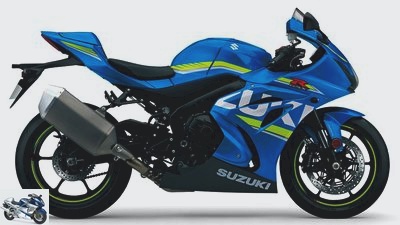
Suzuki
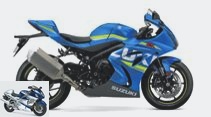

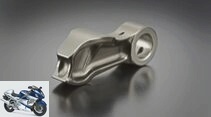
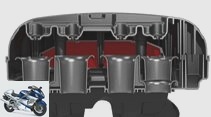
20th pictures
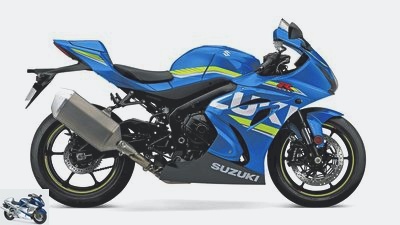
Suzuki
1/20
The Suzuki GSX-R combines high tech with clever engineering.
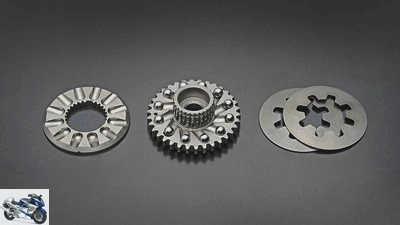
Suzuki
2/20
This centrifugal force mimic adjusts the timing on the intake camshaft, simply and efficiently.
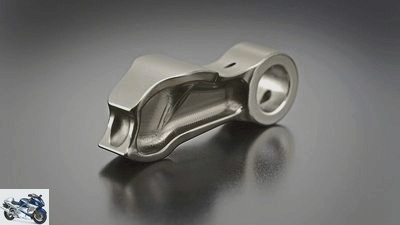
Suzuki
3/20
Coated rocker arms for valve actuation increase the speed stability.
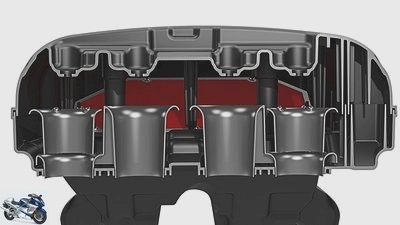
Suzuki
4/20
The outer cylinders of the GSX-R suck in at high speeds through short funnels.

Suzuki
5/20
Here the centrifugal force mimic is based on maximum overlap of the control times, i.e. the highest power and speed.

Suzuki
6/20
The outer and inner bends are connected by flap controlled interference tubes. These open at high speeds.
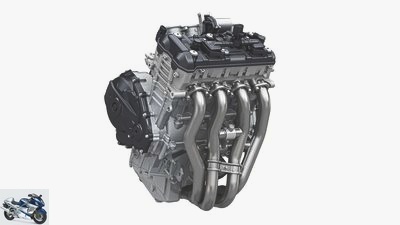
Suzuki
7/20
The new Suzuki GSX-R-1000 engine sets standards. Compact, ingenious and trimmed with all the tricks for maximum performance in all situations. An elaborate development that puts the competition under pressure.
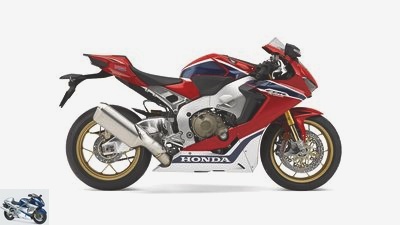
Honda
8/20
Honda Fireblade SP.
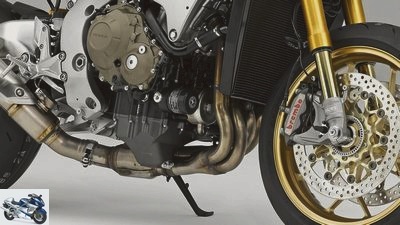
Honda
9/20
Only at first glance it looks the same as it used to be: Honda Fireblade with much lighter components and an engine that has now been upgraded to 193 hp. Thanks to the titanium insert and a slimming diet on the chassis, the single-seater blade now weighs only 196 kilos.
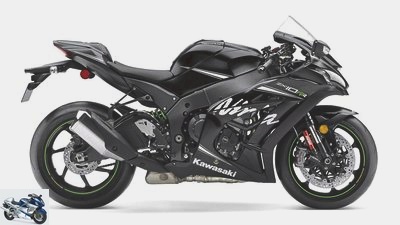
Kawasaki
10/20
Kawasaki ZX-10RR.
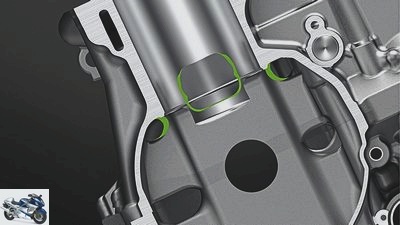
Kawasaki
11/20
The crankcase has been reinforced, the holes marked in green are used to equalize the pressure.
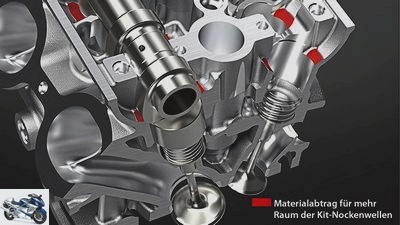
Kawasaki
12/20
In order to be able to accommodate the sharp kit camshafts, the
Cylinder head material are removed. The bucket tappets are for
Coated to minimize friction.
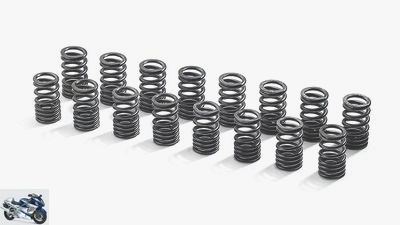
Kawasaki
13/20
Sharper cam profiles with more valve lift also require harder valve springs. Here are the kit versions.
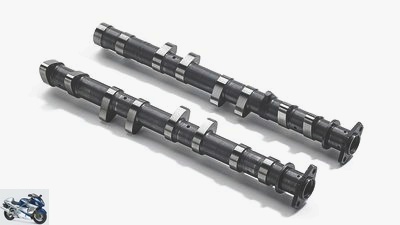
Kawasaki
14/20
You can see their violent valve lift directly on the kit camshafts. With them, the 200 hp limit should fall.
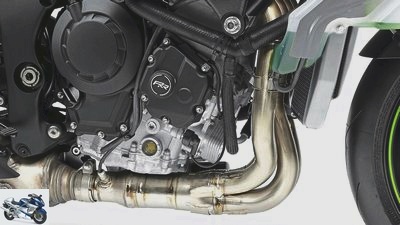
Kawasaki
15/20
Only 500 pieces of the RR version are to be built. Just the thing for active racing drivers.
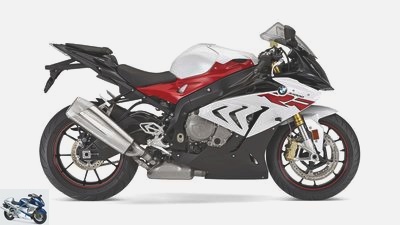
BMW
16/20
BMW S 1000 RR.
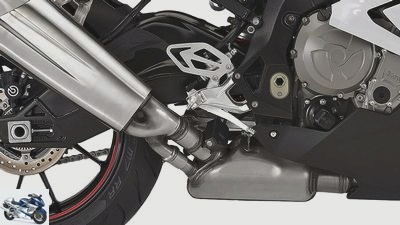
BMW
17/20
Tricky connecting pipes between the collector and the muffler in the Euro 4 version enable exhaust flap control.
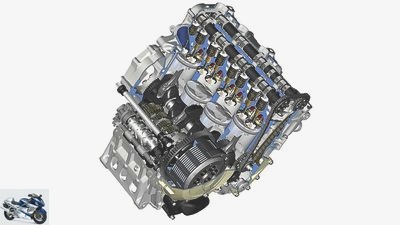
BMW
18/20
Blueprint for the competition? The S 1000 RR engine remains an important player in the match. In the meantime, the Suzuki in particular is following suit. We can look forward to the tests.
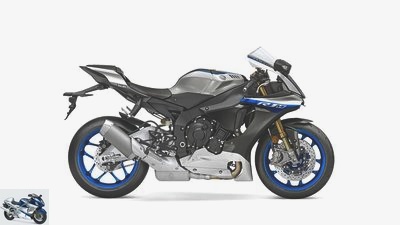
Yamaha
19/20
Yamaha YZF-R1M.
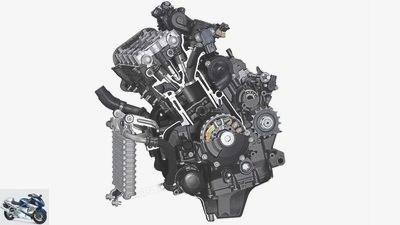
Yamaha
20/20
The radically designed Yamaha R1 was consistently developed for use on the racetrack. Your unique crossplane engine
does not deliver most of the performance, but it is robust and very compact. He will reposition himself in the Euro 4 field.
counselor
technology & future
This is how the new super sports technology works
Tech tricks from Fireblade, GSX-R 1000, R1 & Co.
That is what makes the new supersport motorcycles so good
Content of
Honda and Suzuki bring completely new superbikes, BMW and Kawasaki have revised their machines. Where is the Yamaha R1? The cards in the 1000 game have been reshuffled. PS explains the technology.
Michael Pfeiffer
11/08/2016
Craziness! The colleagues have been writing the super sports segment to death for years and then this: Honda and Suzuki are bringing completely new 1000s. And BMW, Kawasaki and Yamaha, the other three brands with four-cylinder in-line engines, will not be shocked by the new exhaust and noise regulations either, but remain fully active in the competition. PS always believed in it. And now it comes true. It is progressing. With high-tech at its best, with unprecedented development effort and with performance data that will satisfy even the most spoiled among us. In addition, the manufacturers now employ a whole armada of electronic helpers, so as not to let us fall on the trap too quickly.
Buy complete article
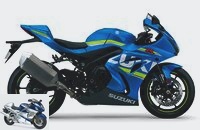
Tech tricks from Fireblade, GSX-R 1000, R1 & Co.
That is what makes the new supersport motorcycles so good
8 pages) as PDF
€ 2.00
Buy now
The greatest effort went to Suzuki. The completely newly developed GSX-R 1000 combines everything that is good and expensive. And what makes it really fast. Suzuki specifies a whopping 202 hp for the new inline four-cylinder, which is a classic screamer like in the last 30 years of GSX-R history. In Japan, the MotoGP configuration with its irregular firing order had probably been considered extensively. But then decided for the street motorcycle for the normal route in order to avoid disadvantages in terms of power delivery in the lower and medium speed range and weight due to the additionally required balance shaft.
GSX-R 1000 combines high tech with clever engineering
Nevertheless, the cylinder head of the new Suzuki GSX-R 1000 inherits a lot from the now successful MotoGP bike. Variable valve timing, rocker arms, variable intake lengths and an additional central injection nozzle above the throttle valve should generate a wide range of performance. These efforts are supported by a complex exhaust valve control between the four manifolds. Mega? Mega! But: Suzuki uses clever engineering to keep the solutions simple. The variable timing creates a centrifugal force mimic through twelve balls. The faster the intake camshaft rotates, the faster they press outwards on defined paths. The gimmick: The shield connected to the camshaft has central ball tracks, the shield connected to the timing chain is slightly tangential. If the balls move outwards, the intake camshaft opens earlier and the valve timing becomes sharper. An ingenious solution, mechanically simple, hardly needs any installation space and works almost wear-free.
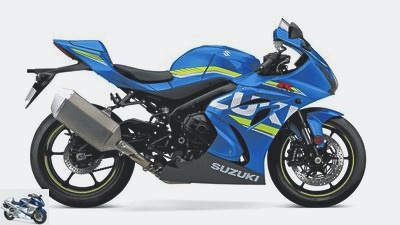
Suzuki
Bad lap times on the Suzuki GSX-R 1000 mean bad drivers.
The Suzuki engineers have found the variable intake lengths even easier. The two outer intake funnels are designed in a cascade shape. At higher speeds, the motor sucks in through the short funnel and thus generates a little more power.
In order to have enough speed reserves in the cylinder head, Suzuki uses like Yamaha and BMW now also on rocker arms. These specially coated levers reduce the moving masses and allow the GSX-R 1000 a speed limit of an astonishing 14,500 rpm. The engine, which is not too short-stroke, reaches its 202 hp at 13,200 rpm.
The new GSX-R engine was not only shorter and narrower, its cylinder bank is also slightly less inclined than before. In this way, the pivot point can easily move forward and a longer swing arm can be installed. The GSX-R driver is now positioned a little further forward and can thus better control the front wheel. Of course, the new Suzuki has the best Showa suspension elements, great Brembo brakes and a handsome electronics package with everything you need. The Suzuki GSX-R 1000 R version gets a little more of everything, even a blipper and a launch control for the perfect traffic light start. Thanks to the complex sensor box and drive-by-wire, the GSX-R comes up with traction control, an ABS system that is suitable for bends and wheelie control. Much has already been tried out in the MotoGP racing machine. So there is no pardon. Bad lap times on the Suzuki GSX-R 1000 mean bad drivers. It can definitely no longer be due to the material.
Honda Fireblade SP and SP2
Of course, the new Honda Fireblade also claims that. Even if a lot of the Blade 2017 looks like the Blade 2016 at first glance, Honda has done more than just a slight model revision. You don’t just save 14 kilograms in weight, and 11 hp more power is not generated by itself. The chassis, which has only been slightly modified in terms of geometry, has been lightened, as has the engine, which received a new cylinder head with larger valves and sharper control times for 193 hp.

Honda
With a full tank of 196 kilograms, the new Honda Fireblade is said to be the lightest in its class.
Bore and stroke remain as before, so that performance-promoting speed yaw remains limited. At 13,000 rpm it is over, the maximum output is at 12,500 rpm. The Honda gets the kick from its low weight, which was also reduced to 196 kilograms thanks to a lipo battery.
Honda offers three versions: the standard blade for trips with two people, the SP with a single bench seat and the SP2 with an even more powerful engine thanks to a special cylinder head and lighter wheels. Striking in all three: the new, much slimmer and more aggressive design. In addition, the blade now shines with a great workmanship and the abundant use of titanium parts for weight reduction. A titanium tank is used for the first time, and the more throughput-friendly exhaust system is also partly made of aircraft construction metal.
Of course, the Honda is also kept in check by an elaborate electronics package that, similar to Suzuki, includes everything from cornering ABS, traction and wheelie control to drag torque control. From the SP version, the semi-active Ohlins chassis is also used. The gentlemen’s horsepower testers will have a lot to test, racetracks around the world, here we go!
Kawasaki ZX-10 RR
Kawasaki has already got there. With the ZX-10R, the Greens again won the Superbike World Championship. And to keep it that way, they add the ZX-10RR, which has been specially improved for the racetrack.
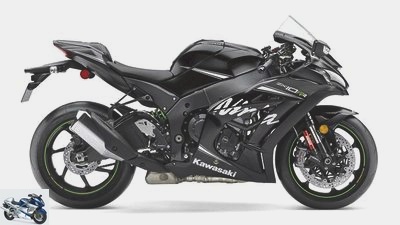
Kawasaki
Only 500 pieces of the RR version are to be built. Just the thing for active racing drivers.
Like the Fireblade SP2 and the Suzuki GSX-R 1000 R, the Kawasaki Double-R will only be built 500 times. In return, she receives everything that does quickly. For example, it is already prepared for sharper kit camshafts, which are supposed to increase the power again and allow the 200 hp limit to be exceeded. The crankcase was reinforced because of the possible additional power. Special openings are intended to reduce pumping losses in the housing.
In order to minimize internal friction, coated bucket tappets are used in the Kawasaki ZX-10 RR. Nevertheless, a further increase in performance will probably only be possible through a radical redesign.
Thanks to an equally complete electronics package with intelligent ABS, blipper, traction and wheelie control, launch control and engine braking torque control, the Kawasaki ZX-10 RR lacks nothing. Lighter Marchesini forged wheels and Brembo M50 monoblock calipers work together with the high-quality spring elements without electronic control. In addition, there are also adjustable steering head and swing arm bearings in a racing kit, so that the ambitious hobby racing driver, but also the professional, should not lack anything.
BMW S 1000 RR and Yamaha YZF-R1
BMW has been using S 1000 RR the standard. The previous test machines with up to 212 hp were almost unbeatable in all tests. Then there was the unparalleled electronics package – and: The S 1000 RR is the only super sports bike with heated grips! For 2017, the pioneering rocker arm inline four-cylinder had to be converted to the Euro 4 regulations. What the BMW press release hides: Not only has the electronics been adapted, but a clever exhaust control system has also been developed that uses a bypass between the front silencer and the muffler. BMW can thus provide an unchanged peak output of 199 hp and a wide torque window of over 110 Nm.
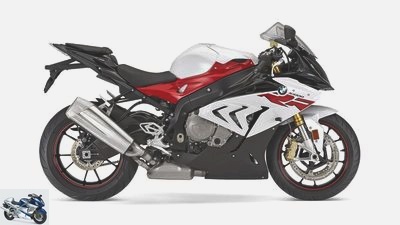
BMW
BMW S 1000 RR. BMW and Yamaha rely on their proven machines. Let the competition catch up first.
Technically, the BMW S 1000 RR engine is not unlike the Suzuki engine. With the exception of the adjustable inlet camshaft, which the GSX-R-1000 now has ahead, the now eight-year-old Bavarian design also has all the modern elements of a top super sports car.
New for 2017: an additional electronics package with further improvements to ABS and traction control. There are also numerous HP parts through to beautiful forged wheels or carbon parts.
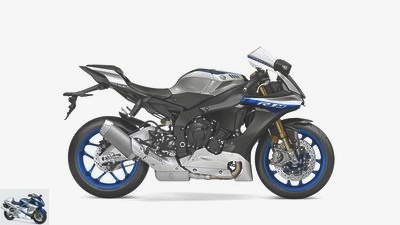
Yamaha
Yamaha YZF-R1M.
Yamaha is also relying on the tried and tested for 2017. The unique R1 with its razor-sharp handling and radical seating position is something for absolute sports riders anyway. Uncompromising racing technology paired with an electronic safety package – the R1 is at the height of the competition.
What sets the Yamaha YZF-R1 apart: The inline four-cylinder ignites irregularly. The crossplane design, in which the crank pins are not offset by 180 degrees, but rather by 90 degrees, simulates a 90-degree V4 engine. And it delivers a robust engine sound that always gives the impression of a lower speed than the one that is actually present. This technology, which comes directly from the M1 world champion machine, is complex for a street motorcycle, but has now become a Yamaha specialty. To counteract the vibrations that occur, a balance shaft rotates in the crankcase.
The Yamaha cylinder head also houses a speed-fixed rocker arm valve control and thus joins the speed masters Suzuki and BMW. The three engines shouldn’t have any major problems with top performance in the Euro 4 trim either. How do the bucket tappet engines from Honda and Kawasaki fare? As always, the truth will speak to the test bed. The power should be enough on all five superbikes, which also don’t give anything away when it comes to electronics – 2017 will be exciting!
Equipment in detail
BMW
S 1000 RR
Honda
Fireblade SP
Kawasaki
ZX-10RR
Suzuki
GSX-R 1000
Yamaha
YZF-R1
199 hp at 13,500 rpm
Related articles
-
Technology: engine technology super sports car
fact 23 pictures fact 1/23 The Honda Fireblade has been a great performer for twenty years. PS takes a close look at the development of engine…
-
Technology of the new 600 super sports car
counselor technology & future Technology of the new 600 super sports car Technology of the new 600 super sports car New base The new 600 super athletes…
-
Kar Lee Kardesign: super sports car with a retro design
Card design by Kar Lee 10 pictures Card design by Kar Lee 1/10 The Ducati Supersport 939 with the paintwork of the Ducati MHR 1000 Mike Hailwood Replica….
-
Comparative test of super athletes
motorcycles Super athlete Comparative test of super athletes Comparison test of the super sports car, Suzuki GSX-R 750 fire-free The new hunting season…
-
used super sports car for the racetrack
www.factstudio.de 12th pictures Honda 1/12 Honda CBR 600 RR, 2003. With a little luck and patience, you can find an offer for the first model series…
-
motorcycles Enduro Technology Honda CRF 450 R Technology Honda CRF 450 R For the sake of simplicity Why complicated when it can be made easy? This is…
-
Technology Superbike developments
Suzuki 16 pictures archive 1/16 Variable valve control Suzuki GSX-R 1000/2016. archive 2/16 Suzuki engine technology in detail: low speed. archive 3/16…
-
600 series super sports car used overview
jaime de diego 43 pictures fact 1/43 Positive: engine speed hornier, more toxic Engine, chassis consistently geared towards racing Model RJ11 compression…
-
Technology: BMW S 1000 RR engine in detail
BMW 13th pictures Artist 1/13 The on-board tool kit of the BMW almost ties in with old traditions. With the help of the nine-part set you can strip the…
-
A comparison of the super sports car MV Agusta F3 675 and Triumph Daytona 675
jkuenstle.de 11 pictures jkuenstle.de 1/11 The Triumph Daytona 675 (right) breaks all prejudices against 600s – at the same time, the elegant and handy…